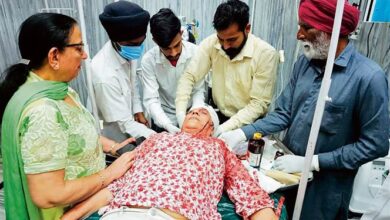Beyond the walls of the institution
Professor Poorna Chandrika of The Institute of Mental Health’s Department of Psychiatry recalls coming across a tatty letter asking for a sibling who was living in the institution. Although visits were infrequent, the institution did send additional postcards to their loved ones urging them to see the patients. In the past, mental illness was associated with insanity, and its remedies included leg and arm shackles and seclusion. But as the discipline develops and the nature of treatment and recovery changes, the situation is clearly shifting.

In the 18th century, when India was ruled by the British, the Madras management board made the decision to establish medical facilities. One of the biggest and most established institutions in South Asia, the Institute of Mental Health (IMH) was founded in 1793. Since this institute’s founding, patients have received strict custodial treatment, which included locking them up, for decades. “During those times when medications were not introduced to the world of psychiatry, patients were treated with native therapy such as blister treatment, hot and cold showers, and so on,” explains Dr. Sanjiv Jain, an Emeritus professor at NIMHANS.
A pivotal moment
Anti-psychotic medications and electroconvulsive treatment were first introduced in the 1930s, and prescriptions for contemporary medications, tranquilizers, and antidepressants were first written in the 1950s. This revolutionary development in the area of psychiatry significantly reduced the discomfort of several grueling therapies. Following the discovery of medications, the number of instances of solitary confinement also sharply decreased. According to Dr. R Thara, vice chairman and co-founder of SCARF, “the issues regarding solitary confinement were brought to light by the NHRC study on mental hospitals.”
Solitary confinement is now seen as a violation of human rights. Numerous people complained about severe treatment they had received in asylums; these accusations stemmed from infrastructural flaws that caused overpopulation. Reforms in the field have also been prompted by ongoing accusations and public attention, according to Dr. Sanjiv Jain. The primary reason of overpopulation for millennia was the lack of an exit strategy for those accepted to institutions.
“This issue led to a movement of deinstitutionalization in the state, and as the concept of long-term stay in asylums started to die away, there was less dependence on the institution, giving them the agency they deserve and ensuring a good quality life,” says Dr. Kishore Kumar, the director of The Banyan, an NGO that helps people with mental illnesses. He echoes this concern. Many of those who recovered from their diseases found acceptance in the community, but the drawback was that many of them found it unbearable to think of returning to their families, and there was nowhere for the other group of individuals to go.
Beyond prescription drugs
Gradually, it became apparent that the meaning of care extended beyond medical procedures. As mental health services began to expand, more NGOs were created. According to Dr. Kishore, The Banyan’s founding was a societal reaction to the impending suffering of the poor who suffer from mental diseases. “The best place for recovery is at home,” he declares. With this idea in mind, the organization began offering community-based care and outpatient clinics; also, it offered an inclusive living environment with psychosocial support for those in need of long-term care.
The World Health Organization recognized their program Home Again as a long-term care option and included it in the list of 21 global programs.
Even though the number of mental health professionals, the involvement of the commercial sector, non-governmental organizations, and the focus on long-term care have increased recently, there have been some horrific events throughout history that have marred the mental health care industry.
A battle between science and religion
According to Dr. R Mangala, a consultant psychiatrist with SCARF, there was a change in the way services were provided after the 2001 Erwadi tragedy, in which 26 individuals with mental illness who were tied to trees and burned alive while a fire broke out. “Despite being available on paper for many years, district mental health care services did not begin to function effectively until after this incident.”
It was difficult to challenge people’s belief systems in this deeply religious and superstitious state, and faith healing could not be completely eradicated. A long-standing custom at the Gunaseelam Vishnu Temple in Tiruchy, which is renowned as a therapeutic location for those suffering from mental diseases, is to house those suffering from mental illnesses on the temple grounds for a set amount of time.
These days, patients may get medication in a rehabilitation facility with a government license. The rites of the temple are also observed in addition to this. This shows how to find a medium ground and see how clinics and temples collaborate. Dr. Mangala also remembers the idea of dava-dua, which she seen in numerous Puducherry dargahs while her employment there. In dava-dua, individuals are persuaded that drugs may heal and reduce symptoms without challenging their belief system.
Dr. Sanjiv gives credit to the mental health professionals, Drs. Dhairyam, D Sharada Menon, O Somasundaram, and Venkoba Rao, who significantly improved the situation and turned IMH into an active teaching environment. Dr. Poorna also acknowledges her appreciation for their noteworthy 1949 introduction of occupational therapy. The patients were encouraged to take up hobbies like as baking, gardening, weaving, tailoring, woodworking, etc., according to her.
Anticipations
Regarding government involvement, Dr. Sanjiv states that “every district has a psychiatry section, and the government is investing in mental health care programs.” A long-term strategy should be in place, spanning 20 to 30 years, however, since many individuals may not fully recover from their illness and may live a long time with it. Consequently, care and attention must be provided to this group of individuals as well.
One issue we have in our nation, according to Dr. Kishore, is the acceptance of the mentally ill by society and the system, who feels that the idea of regulating persons with mental diseases has progressively transformed to delivering a patient-centric service.






